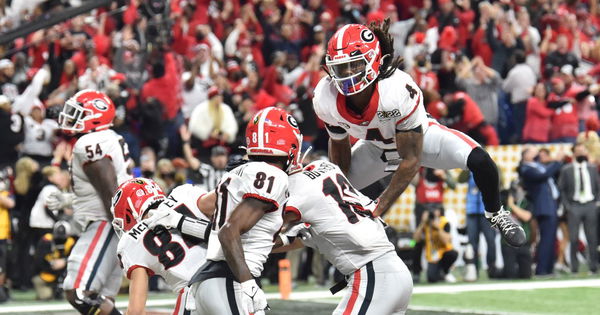

Welcome to the reality of the NIL landscape. College football is no longer just about the Saturday grind or the next 5-star recruit. It’s morphing into something way more complicated. You’ve probably heard of the NCAA v. House settlement. The one that could flip the script on how college athletics operate from CFB powerhouses like Georgia to Rutgers. Forget the usual scholarship limits—we’re talking roster caps, salary caps, and schools actually paying players directly.
But it’s not just legal stuff behind the scenes anymore. Big names are speaking up. Even legends. Georgia Bulldogs former linebacker David Pollack, class of 2001-2004, took to X on April 10 and pulled no punches. He was replying to Outkick.com founder Clay Travis, who tossed out a wild but very possible scenario—“At some point one of the richest guys in the country is just going to endow billions of dollars in NIL and buy his school all the best players. Feels inevitable to me.” Pollack’s response?
“The July salary cap for college football will now prevent this from happening, but…” he trailed. “20.5 million for all sports to split is gonna be a nightmare. A lot of coaches gonna be fighting their other programs for more funds.” See, it’s not just about fairness anymore; it’s going to be about the survival of the fittest.
ADVERTISEMENT
Article continues below this ad
The July salary cap for college football will now prevent this from happening but…
20.5 million for all sports to split is gonna be a nightmare. A lot of coaches gonna be fighting their other programs for more funds. https://t.co/EvUaqSXZUM— David Pollack (@davidpollack47) April 10, 2025
Right now, SEC and Big Ten powerhouses—schools like Georgia—are sweating over one number—$20.5 M. That’s the caption every athletic department would get to spread across all sports under the new revenue-sharing model. Sounds like a lot, right? Not when you realize football alone is set to eat 75% of it. Men and women’s basketball? They’ll grab 15-20% and 5-10%, respectively. And the rest… Well, good luck to the Olympics and non-revenue sports.
Tennessee’s already hiking up ticket and concession prices, calling it “talent fee.” Other schools? They’re scrambling to fundraise like it’s a do-or-die. And it kind of is. Take Nico Iamaleava at Tennessee. A high school QB signing an $8M NIL deal over three years. He’s basically become a walking, throwing experiment. Will that kind of money translate to wins? And with him reportedly negotiating again, right around the time of the spring transfer portal window, it sure looks like he’s using it as leverage. Can you blame him?
ADVERTISEMENT
Article continues below this ad
Regulation vs. reality—What’s going on behind the scenes?
Former SEC insider John Talty laid it out perfectly during a 247Sports appearance. “What’s funny is that people are asking for regulation but also making plans to try to get around that regulation,” he bluntly stated. “That’s just part of what is college sports where everyone wants it to be kind of an even playing field. And yet you have these collectives and other people involved that are going to try to do everything they can to allow their school to have an edge over the others.” Sounds about right.
What’s your perspective on:
Is college football's NIL era a game-changer or a disaster waiting to happen?
Have an interesting take?
Because at the end of the day, college football isn’t some wholesome amateur sport anymore. It’s a high-stakes game of strategy, boosters, and billion-dollar decisions. And for schools like Georgia, Alabama, and Ohio State, the ones used to dominating, this new era isn’t just about recruiting talent. It’s about finding the money to keep that talent in your building.
ADVERTISEMENT
Article continues below this ad
The NIL spiral isn’t slowing down. And if even someone like David Pollack is waving a red flag, maybe it’s time to take a harder look at what college football is becoming.
ADVERTISEMENT
ADVERTISEMENT
ADVERTISEMENT
ADVERTISEMENT


Is college football's NIL era a game-changer or a disaster waiting to happen?